Wake County Home for the Poor, Near Raleigh, N.C.
Flashback Friday takes a visit this week to the former Wake County Home for the Aged and Infirm, which was built on the outskirts of Raleigh in 1915. The County Home is no more, but the repurposed building itself still stands on Whitaker Mill Rd.
There is a message this week, but it has to be one of the most puzzling I have ever encountered on a postcard.
Dear Emmie /Â we are still on the road /Â dont worrie / I think every things is all rite /Â Plea[ase] dont worrie / will rite you a letter just as soon as we [illegible] / I am worried about [illegible]
Yours Alderman[?]
I noticed the postmark is dated August 1918, just three months before the end of WWI. But who is ‘Emmie’? Who is ‘Alderman’? And why is everyone so worried?
Maybe the stamped mark on the back of the card is a clue.
American Red Cross
Richmond, Va. Chapter
Canteen Committee
Any GNR readers care to take a stab at this?
As is common with many postcard correspondents, the message does not relate to the image on the card at all. This image is that of the Wake County ‘Home for the Poor.’ The facility was only three years old when the postcard was mailed.
The Wake County ‘Poor House’
Wake County established the Parish Grove ‘poor house’ and farm to house indigent residents in the 1820s. It was located northwest of the city on 500 acres of depleted, rocky soil, in the area between what is today Leadmine and Six Forks Roads. The site included 200 cultivated acres — the county farm — a public gristmill on Mine Creek, and facilities for the carding, spinning and weaving of cotton from which the inmates produced their own clothing.
By 1892 the poor house comprised nine two-room frame buildings, each 16’x36′, heated by open fireplaces or stoves, and lit by oil lamps. The population included 35 white adults and 40 African-Americans. Under cultivation on the farm were corn, cotton, oats and clover, among other staple crops.
A.W. Shaffer’s 1887 map of Wake County details the location of the poor house, also referred to at the time as the county ‘work house.’
The ‘Poor House’ Becomes the County Home
In 1913 Wake County commissioners established the county ‘Home for the Aged and Infirm’ to care for indigents and others who had no means of support. The Parish Grove property was sold, and a 35-acre site for the county home was selected on the former Whitaker family property, located just north of the city limits. They hired Raleigh architect Charles E. Hartge (who had also designed the Church of the Good Shepherd) to erect a modern institutional-style facility.
Hartge designed a two-story brick building composed of three wings with 150 private rooms, steam heat, electric lights, hot and cold running water, reception and recreation areas, modern kitchen facilities, dining rooms, sunrooms in each wing, and an apartment for the superintendent and his family. The new building also included a segregated residential wing and dining room for African-Americans. The new building was completed in October 1915, and 89 county poor were transferred from Parish Grove to their new ‘mansion’ in Raleigh, as some of them called it.
This photo of the County Home was taken in 1939.
Life at the County Home
Life at the county home was no picnic for its residents, who included not only the ‘poor,’ but the mentally ill, orphans, and the disabled, as well. Their lives were regulated ‘by the bell,’ and most residents of the home had to work on its farm or perform other duties if they were physically able. Although it was not an easy life, it was a vast improvement over life in the ‘poor house’ of the 19th century. Sadly, though, many residents were often forgotten by their families, or had no family at all.
For more than 60 years the Wake County Home for the Aged and Infirm cared for those who could not care for themselves, or who had no one to care for them. Upon death, an adjacent cemetery became the repository of their mortal remains.
With the advance of more adequate health care systems, the County Home closed in 1979. The building now houses a senior center and county welfare offices.
A resident of the County Home poses before a bed of canna lilies about 1930.
A Lasting Legacy
Residents of the home make up the majority of those buried in the cemetery, but the county also apparently used it as a general paupers field. From 1915 to 1976 nearly 300 individuals were buried in unmarked graves on the property. There they rested, forgotten, for thirty years. During that time, members of neighboring Emanuel Baptist Church tended to the burial ground, which was marked by a single broken headstone.
In 2008 the lost cemetery came to light during preliminary planning for a new senior citizens center to be built on the grounds. A subsequent series of stories by The News & Observer brought it before the public eye, and a popular campaign ensued to formally recognize and commemorate those buried in the abandoned cemetery.
The Wake County Board of Commissioners agreed, and authorized a monument to be erected on the site. In August 2010 a simple granite marker was dedicated to these long forgotten residents of the County Home. It reads: “In loving memory of those Wake County residents laid to rest near this location from 1915-1976.”
Our Flashback Friday ‘white border’ postcard this week was published by long-time Raleigh stationer James E. Thiem. It was printed by the Curt Teich Co. of Chicago under the trade name ‘C.T. American Art.’
Curt Teich Co.  1893-1974 Chicago, IL
A major publisher and printer. Their U.S. factories turned out more cards in quantity than any other printer. They published a wide range of national view-cards of America and Canada. Many consider them one of the finest producers of White Border Cards. The Linen Type postcard came about through their innovations as they pioneered the use of offset lithography. They were purchased by Regensteiner Publishers in 1974 which continued to print cards at the Chicago plant until 1978.
“Flashback Friday†is a weekly feature of Goodnight, Raleigh! in which we showcase vintage postcards depicting our historic capital city. We hope you enjoy this week end treat!

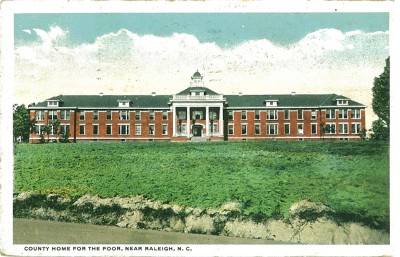
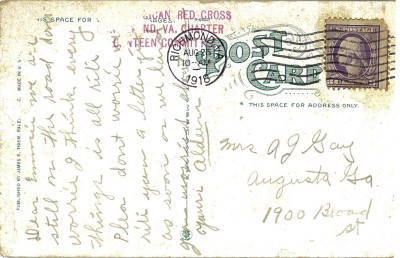
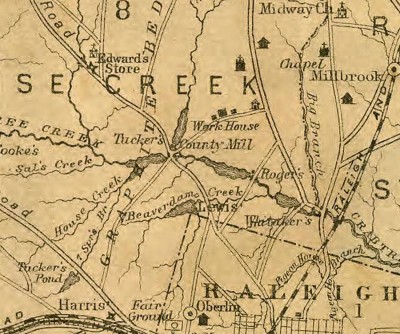
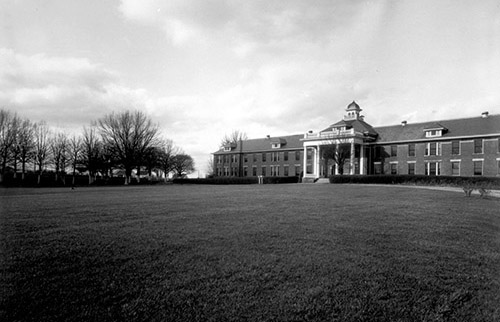
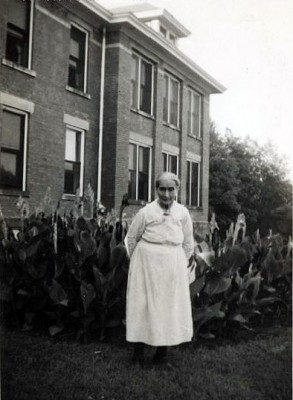

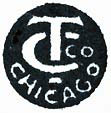
 Sign up for the Newsletter
Sign up for the Newsletter
10/11/2013
You forgot to add that the site was also a juvenile home as my step-brother was there for awhile for breaking the law.
Currently, it used by Monarch, a provider of mental health care such as therapy.
10/12/2013
I spent my elementary school years living very close to the County Home. My friends and I frequently played in the woods and fields behind the building. On Halloween we would hang out in the cemetery. On one occasion I went into the building and I remember it, the main hallway, as very dark and cool. In high school my Health Careers Club visited the people there. We would simply sit and talk to them in a sun room or parlor. That was a strange experience which I did not appreciate fully at the time. The juvenile facility was cool too (from the outside). Walking down Noble Rd from the Poor Man’s Store (intersection of Pine Drive and Whitaker Mill Road) would walk by and see faces at the windows and sometimes there would be kids outside behind the chain link fence and seeing them there made us glad for our freedom. Seeing the kids there quite possibly kept us out of serious trouble.
10/12/2013
The original county home site was behind an elementary school on Northbrook Road (for the name of the school). I have read about a cemetery that is there somewhere but it may have been moved. The site is a large clearing in the woods with a handful of ancient oaks that surely were the “yard” trees of the living quarters. The map is cool…Whitaker Mill, Lassiter Mill, Wake Forest/Falls of Neuse and Lousiburg Roads are all there along with many others such as the defunct “upper” Hillsborough Road (McDonald Lane and northern Oberlin represent part of that track). Thanks for the article.
02/14/2014
I have actually located part of the graveyard from the old poor farm at Parish Grove behind Brooks Elementary School. Unfortunately most of the plain stone markers have been moved by kids from the school playing, not knowing the significance of the odd-looking stones they were tossing around. But I have found some undeniable grave markers kept safe from the kids by heavy brush and undergrowth. A few people wanted to jump on a bandwagon and clear out the brush and undergrowth so everyone can see the few remaining graves. I say let them lie in peace, and leave the brush to continue to protect them from harm. The headstones are not marked, but if you see them there side-by-side, head and foot, and know the history of the red clay bricks that were also made by the farm workers, you will agree that these are indeed graves from the old poor farm. I will be glad to show anyone if they want to crawl beneath the bushes to see them. Not much to see, unless you know what you are looking at, and know the history of them.
02/15/2014
I was inside this building (commonly called “the poor house”) once when I was about 15…one Sunday evening before Christmas our MYF group at nearby Hayes-Barton Methodist went caroling at both the County Home and Mayview Nursing Home next door. To say that these two places were like night and day would be a great understatement. Going to a well-maintained place like Mayview was no barrel of fun, but the County Home…whew, that was just sad. I’ve never forgotten it.
02/15/2014
The graves I mentioned are from the OLD Poor Farm, in the community that was then called Parrish Grove. It is near Mine Creek, where they operated a grist mill, off Crabtree Creek. The graves are in what is now the North Hills subdivision. The Old Poor Farm had no water or electricity, with very harsh living conditions, and they had to work on the farm, or in the grist mill, or cotton mill, or the kiln, making bricks. In 1915 it was moved into the huge brick building shown above. When they moved from the old rustic living conditions to the nice brick building with running water, electricity, and heat, they must have thought they were moving closer to Heaven.
03/06/2014
My memory of Wake County Home was my family visiting my special Aunt Hettie Richardson Bridgers at the TB Sanitorim next door. Children were not omitted – that made for many long Sunday afernoons. Twice my mother slipped me in to see my aunt when she was on the sun porch. Other times, my Mom and I went to see a girl called “Cracker Jack” on the second floor of the Wake County Home. I loved her and could still, 70 + years go to her room. Thanks for allowing me to walk down memory lane. Barbara Bridgers Barham
02/03/2015
Does anyone know where the records for the County Home are archived? I had an uncle who’s death certificate states he was an inmate in the Wake County Home. I would like to research this but am having trouble finding where all the records are.
Also does anyone know the amount of detail that is in the records?
Thanks.
02/03/2015
The wake County Home for the poor has had 2 locations. The first location, pre 1915, was very rustic living conditions, outside Raleigh near a community that was known as Parrish Gorve. In 1915 Raleigh opened a new home for the poor on Whittaker Mill Road in Raleigh. The new home was much nicer, with electricity,running water, and central heat.
Olivia Raney History Library has the most information on the early Poor Farm, with a partial list of people buried there, mostly in un-marked graves. The records are by no means complete. The newer home also has a graveyard, with headstones for everyone buried there. The records are probably at the NC Dept. of Archives and History. I tried to find burial records of an ancestor who died at the old Poor Farm, with no luck. But I had the date of his death. I went to the Olivia Raney History Library and searched the News and Observer archives around the date of his death. They did not have a separate obituray section back then, but I found a short mention in the paper that he was being buried in Oakwood Historic Cemetery in the Civil War section, since he was a Civil War Veteran.
02/03/2015
Here is a link to a more complete story about the history of both Wake County Home for the poor:
http://cemeterycensus.com/nc/wake/269/269-article2.pdf
08/05/2017
The search for my great-great aunt, Mary L. Reavis, has ended at the Home for Aged and Infirm on Whitaker Mill Road. In 1887, Mary left her husband, John Vaughan of Vance County. I recently discovered Mary married John Vail Wilson in Wake County in 1889. J.V. Wilson’s granddaughter was Alice Harper Wilson, NC’s first lady,as she was married to Governor Joseph Broughton, Jr. While all the Wilson family members are buried in Oakwood Cemetery, Mary, the step-mother became one of the “lost souls” of Wake County and ended up in a paupers’ cemetery. According to Mary’s death certificate, Mary died February 27, 1916 of “pellagra disease,” due to a deficiency of vitamin B.
Mary is one of the characters in my historical novel, “Upon These Steps.”
08/29/2018
The secrets this building could tell. I heard from some people who worked there that they would not go into the basement it was just too creepy. One woman said there were manacles attached to the wall at one time and she also thought the building was haunted. I never was there at night not ever in the basement so do not know if this information is accurate.
03/31/2020
David Amos, if you’re still around – I’d love to check out the grave site behind brooks – I live in North Hills and used to play in that area when i was a kid.
09/19/2020
I knew Karl Larson and his brothers back in the ’80s. I remember the movie nights he had at his home. I am mainly interested in knowing what will become of this blog since it still seems to be up and who it is that is taking care of it. I moved away from there around 1990. It seems strange to me now that Karl became the person who was eventually able to solve one of the big mysteries of my childhood later on after I was gone. The story of the Wake County Poor House was of great interest to me as I lived right there for 15 years near EC Brooks School and saw a lot of interesting stuff I could never figure out. Obviously, other people were interested also and thank goodness for history. RIP Karl. You are missed
11/01/2021
Hi there – the image of the elderly woman standing in front of the “new” County Home is Fannie Williams. She was aged 90 years old when the picture was taken. I have the original with the writing on the back of the picture.
11/01/2021
Hi there – the image of the elderly woman standing in front of the canna lilies at the “new” County Home is Fannie Williams. She was aged 90 years old when the picture was taken. I have the original with the writing on the back of the picture.